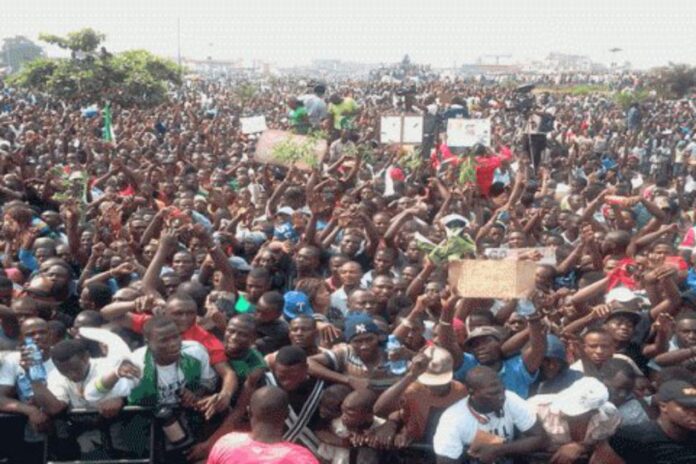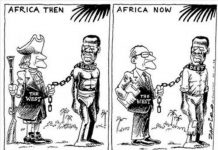In 1989, thousands rose in protest against the IMF and World Bank-inspired Structural Adjustment Programme (SAP). This supported the lavish lifestyles of corrupt government officials while the masses were suffering. The protest movement, initiated by students, was crushed by the Federal Military Government, but it did win some concessions.
Baba Aye of the Socialist Workers League looks at these events which were part and parcel of the season of uprisings across the world. They brought down many governments in Eastern Europe and shocked the Chinese state to its foundations.
The anatomy of a mass revolt
The protest movement was ignited by mass anger against real and perceived corruption in high places. Handbills were circulated by student activists alleging large-scale theft of public funds and the stashing of these abroad by the Head of State, General Babangida (IBB) and his deputy Admiral Aikhomu. A column in the Ebony magazine was presented as the source of this information. But the dissemination of these handbills had their roots in the NANS Senate meeting. This was held a few weeks earlier, at the University of Ibadan, and had resolved on mass mobilisation against the Structural Adjustment Programme.
Immediately after the August 1986 coup d’etat, IBB organised a national debate over the IMF loans and consequent conditionalities. The answer was a resounding NO! He pretended to accept the voice of the people. But SAP was then introduced with the lie that it was a home grown alternative. But this was a shameless falsehood; it was the same IMF/World Bank policies of free market capitalism.
The poor working people were enjoined to tighten their belts and make sacrifices for a better future. But the bosses (military and civilian alike) got much fatter. Corruption was more or less institutionalised. The income of the top 1% soared to high heavens while workers in the public sector had a wage freeze and retrenchment became the order of the day for workers in the private sector. The first major fuel price hike also took place in 1988 as part of structural adjustment. The national structures of the Nigeria Labour Congress (NLC) had been proscribed by then and so it was student activists and ex-students in the emerging civil rights/prodemocracy movement (working closely in most states with trade union councils) who galvanised mass action.
The students of UNIBEN were the first to take to the streets on May 24. The fire spread across the country with campuses as its torch bearers. By May 29, the first embers of this raging fire sparked at Ibadan and Lagos. By 4.00am on May 30, students in campuses across Lagos State started trooping out for what would be two days of pitched battles, including at the barricades set up to block the strategic Lagos-Ibadan expressway.
A dozen in Lagos and at least two people in Ibadan were killed by the anti-riot police in the early days of June. But an important part of this struggle which is hardly mentioned in most narratives is that some mobile (anti-riot) police squads did actually cross over to the masses in the way they could without out rightly mutinying. The death toll would have been far higher if these had not pointed out where their more zombie-like colleagues were lurking.
The NLC stayed aloof from the revolt. Indeed, in the build up to those heady days in May, attempts by radical activists to organise a symposium on alternatives to SAP at the NLC headquarters, Yaba, was rebuffed by the union leaders. The symposium was eventually held at Chief Gani Fawehinmi’s chambers in Anthony Village.
The proscription of NLC a year earlier, primarily for its radical stance on SAP, had just been lifted. A great compromise personified in Pascal Bafyau elected as President was made by the union leaders. Essentially this was to bury the ideological divide between the progressives (radicals) and democrats (liberals), which the state had manipulated to justify the proscription. In practice, this meant a de-radicalisation.
Along with this was the presumed opening of political space for the formation of parties, and NLC was more interested in establishing the Nigeria Labour Party (the military government did not recognise any of the parties that had been formed and set up the two parastatals of Social Democratic Party and National Republican Convention). Even leading left activists such as Comrade Ola Oni who spoke at the Ibadan NANS Senate mentioned earlier also tried to convince the students’ movement to put more faith in building the short lived party than in taking to the streets.
The aftermath: repression and gains
Repression followed the state’s suppression of the “riots”. Acts of brigandage by lumpen proletariat elements within the protest, such as snatching wristwatches and extortion were seized upon to try to criminalise the mass movement.
Six universities considered to be at the heart of the movement were closed for a year (these were all however re-opened in less than a year). In a manner reminiscent of the sacking of radical lecturers after the 1978 “Ali Mongo” protest, teachers such as Yusuf Bala Usman at ABU, were relieved of their duties.
Concessions were however won which confirm the axiom; “dare to struggle, dare to win”. The junta immediately announced that it would ensure the employment of 62,000 persons through the National Directorate of Employment between June and December 1989. Eventually though, barely half of these were employed. The federal ministry of works and housing was also charged with providing jobs, while other ministries were meant to absorb professionals such as doctors, accountants and engineers.
This was also when “mass transit” became a part of our transport system’s features, with buses like those of SURE-P after the January 2012 uprising made available including through the NLC which set up the Labour Transport Company.
The students unions were not left out. Students’ unions across the country were provided with coaster buses. If this was an attempt to bribe the students’ movement, it failed. These buses became very useful for mobilising for subsequent battles, particularly those around the Academic Reforms (ACAREF) Campaign, launched two years later at the University of Ilorin.
But the greatest gain secured from the events of the Great Anti-SAP revolts was not from the state. In its wake the renewal/realignment of radical and revolutionary forces which had started in 1986/87 took on more vigour. It inspired the formation of the Alao Aka-Bashorun-led National Consultative Forum which attempted to organise a National Conference in September 1990 eventually leading to the establishment of the Campaign for Democracy which united left groups and some trade unions a year later. Campaign for Democracy was to be the major vehicle of resistance in the first phase of the six-year June 12 revolution.
Conclusion
A thread of continuity can be traced linking the Great anti-SAP Revolts to the January 2012 Uprising. Similarly, just as with 1989, our struggles today are part of a global wave of resistance.
The masses want a better life and this is why the immense majority rise up against the bosses. But, there is a limit to the extent this can be fulfilled within the logic of capitalism. Besides, the bosses always try to get back whatever concession they are forced to give, as soon as they can. Working people learn from struggle, becoming more radicalised through the schools of victories and defeats.
This is however not enough. Revolutionary activists need to propagate socialist ideas, showing how the different struggles for a better world are linked and that ultimately; this can be won only with the self-activity of the working class and other exploited strata. This necessity has become even more important now with the setback socialist ideas suffered in 1989 as the state capitalist monstrosities that called themselves “socialist states” collapsed.
We have to project the core essence of socialism which is helping an ever increasing number of workers and youth to understand through their struggles and study that in our hands is placed a power greater than the hoarded gold of the bosses. With this strength we can and we shall bring to birth a new world from the ashes of the old!









